Day three of Shoptalk Europe 2023 focused on outstanding retail experiences, digital and omnichannel, grocery workshops, the future of brands, and supply chain innovations. The day was packed with informative sessions and discussions that provided valuable insights into the latest trends and technologies in the retail and e-commerce industry.
How Farfetch is leading luxury fashion’s digital revolution
Stephanie Phair, Chief Customer Officer at Farfetch, reflected on the company's progress since its establishment in 2008. The online luxury fashion retailer's pioneering marketplace model has enabled it to stay at the forefront of industry digitization by connecting boutiques and brands to a global audience. This strategy has resulted in a wide product range and an expansive audience, with 75% of their customers being Millennials and Gen Z.
Farfetch's private clients, who spend a minimum of $10,000 annually, constitute a significant portion of the business. The company boasts a retention rate of over 90% for this group, achieved by identifying potential high-value customers early on and offering them unique perks such as a private client-specific app, early access to brand moments, special content, and a personal stylist.
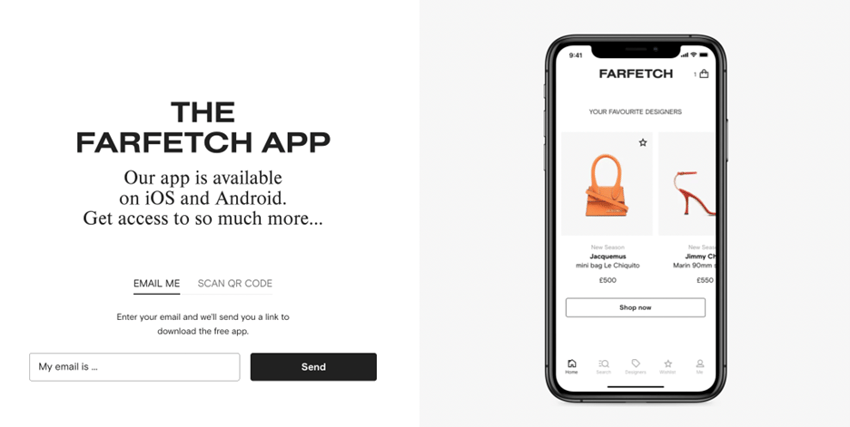 Farfetch is experiencing a retention rate of over 90%, achieved by identifying potential high-value customers early on and offering them unique perks such as a private client-specific app, early access to brand moments, special content, and a personal stylist.
Farfetch is experiencing a retention rate of over 90%, achieved by identifying potential high-value customers early on and offering them unique perks such as a private client-specific app, early access to brand moments, special content, and a personal stylist.
Their app has become Farfetch's fastest-growing and most profitable channel, leading the company to invest heavily in enhancing customer experience. They've noted regional preferences, with some countries predominantly using the app.
Farfetch also focuses on supporting its brand partners by providing a technology platform to help digitize the luxury industry. The pending acquisition of Yoox Net-a-Porter is set to broaden Farfetch's reach and enable further strategic growth. The company is also venturing into retail media, capitalizing on its sizable audience to monetize the platform.
Key takeaways
- Marketplace model: Farfetch's marketplace model has been a successful strategy, attracting a wide audience and offering an extensive range of products.
- High retention rate: The company's focus on identifying and retaining high-value customers has resulted in a retention rate of over 90% for their private clients.
- App is key: The Farfetch app is a growing and profitable channel, with significant investment aimed at improving customer experience.
- Expansion: The company is actively supporting the digitization of the luxury industry and is poised to expand its reach with the acquisition of Yoox Net-a-Porter.
- Retail media is on the rise: Farfetch is leveraging its audience to venture into retail media, providing additional opportunities for monetization.







Outstanding retail experiences: In-store
The first track of the day focused on transforming the store workforce with new roles and capabilities. Retailers and brands are investing in new approaches to management and technologies that empower their store associates and increase productivity. They are also creating new roles that are more fulfilling, such as having store associates support digital sales and social media content generation.
Additionally, leaders discussed how to provide inspiration and ease with innovative store designs and technologies that strike a balance between providing inspiration and making purchases easy and convenient.
COS launches smart store solution in Europe
COS, an H&M brand known for its innovative designs and commitment to sustainability, is set to roll out its Smart Store solution across European stores in the coming year. Christoffer, the Managing Director for COS in Europe, highlighted the potential of the tech-integrated solution to revolutionize customer experience, boost sales, and provide valuable data insights.
The Smart Store initiative reflects COS's commitment to integrating advanced technology into retail, creating an enhanced, personalized, and convenient shopping experience for its customers.
Key takeaways:
- Smart Store integration: Smart Store, a tech solution that has been successfully implemented in the brand's US stores, aims to merge the physical and digital in-store experience. The technology, which includes overhead RFID readers installed across the stores and mobile devices for staff, provides real-time visibility into the location of every garment in the store.
- Customer empowerment: This transparency allows customers, through a downloadable app, and staff to scan an item and access immediate information about size, availability, color options, and style suggestions. The tech also maps the item's exact location, enhancing customer service and potentially driving sales.
- Smart fitting rooms: In the fitting room, RFID readers present items on smart mirrors or tablets, allowing customers to request additional sizes or style suggestions without leaving the room. This feature adds convenience and a personal touch to the shopping experience, aiming to improve customer satisfaction and increase selling opportunities.
- Valuable data: The Smart Store concept delivers valuable data, including heat maps of the store, stock transparency, and conversion rates based on fitting room data. This helps to optimize merchandising decisions and stock management. The data collected gives a lot better view of direct conversion in store, i.e. the item sold has been tried on one time and sold directly or the other way around - tried on a lot of times but never sold.
- Supports BOSS & BOPIS: The system also supports buy online and ship from store and buy online and pick up in store.
- Mobile checkout: The technology enables mobile checkouts, speeding up the transaction process and enhances customer service.
- Easy-to-use app for store staff: To support the customer in a better way for stock lookup, stock transfer, style recommendations and a lot more.
- Promising results: The US implementation of the Smart Store has shown promising results, including elevated customer experience, efficiency improvement, an increase in sales, and data-driven insights. The company expects similar outcomes in Europe.
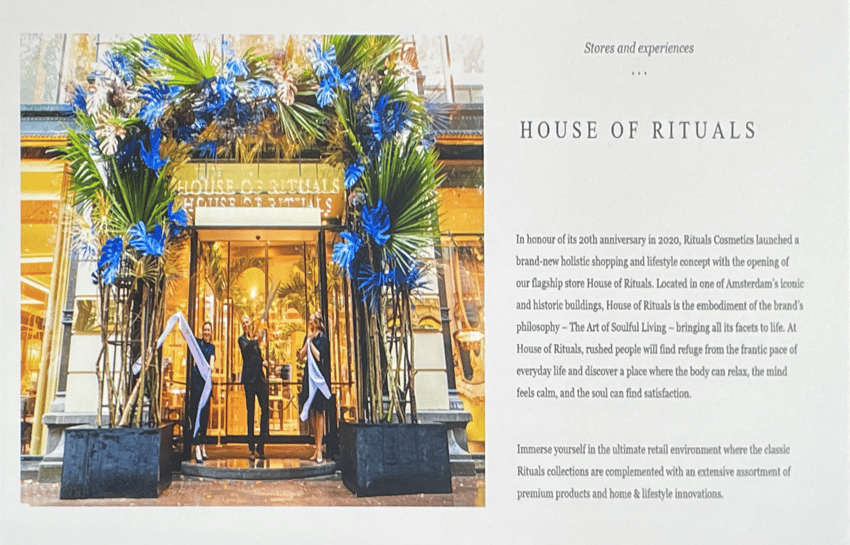 Retailers are moving beyond “omnichannel” into a world where shopping journeys move fluidly across physical stores and websites, social media, marketplaces, and more.
Retailers are moving beyond “omnichannel” into a world where shopping journeys move fluidly across physical stores and websites, social media, marketplaces, and more.
Rituals Cosmetics innovates with beauty tech to enhance customer experience
Richard Lems, Director of Format and Design at Rituals Cosmetics, detailed the brand's innovative use of technology to improve the in-store experience. Rituals Cosmetics, a global company boasting 1150 stores and 3000 stockists, is finding unique ways to leverage technology without losing the human touch that defines their customer experience.
Rituals Cosmetics' approach to technology is not about the tech itself, but about how it can enhance customer experience; whether by personalizing products or offering unique ways to interact with the brand. Their innovative use of technology in retail goes hand in hand with their commitment to delivering a personalized and inspiring customer journey.
Key takeaways:
- House of Rituals: Located in Amsterdam, this 2,500 square meter space acts as a 'beauty tech laboratory' for testing new technologies and concepts. Successful innovations are first introduced to the brand's 100 premium stores before being rolled out to all outlets.
- Hair temple: This technology, now in the House of Rituals, involves a quick questionnaire that allows customers to choose from around 750 different shampoo or conditioner solutions. This process epitomizes the marriage of technology and retail, focusing on serving customers and enhancing their experience.
- Innovative displays: Rituals Cosmetics have designed unique umbrella displays where customers can see themselves in the screen with their chosen umbrella. This interactive concept aims to make even mundane items like umbrellas more exciting.
- Perfume genie: This home-based product allows customers to schedule when their home starts to smell beautiful, adding a touch of luxury to daily life.
- Mind oasis: The brand's latest innovation, the Mind Oasis, focuses on mental relaxation and mindfulness. It doesn't sell any products but aims to encourage customers to care for their minds just as they do their bodies.
Outstanding retail experiences: Digital and omnichannel
The second part of track 1 of the day focused on new approaches to frictionless payments and checkout. Retailers and brands are introducing new payment and checkout options to meet consumer expectations for speed and convenience, such as one-click checkout, crypto payments, Buy Now Pay Later, and automated checkout. Additionally, leaders from outside of Europe discussed the leading-edge retail innovations, including autonomous stores, payment innovations, and new shopping capabilities.
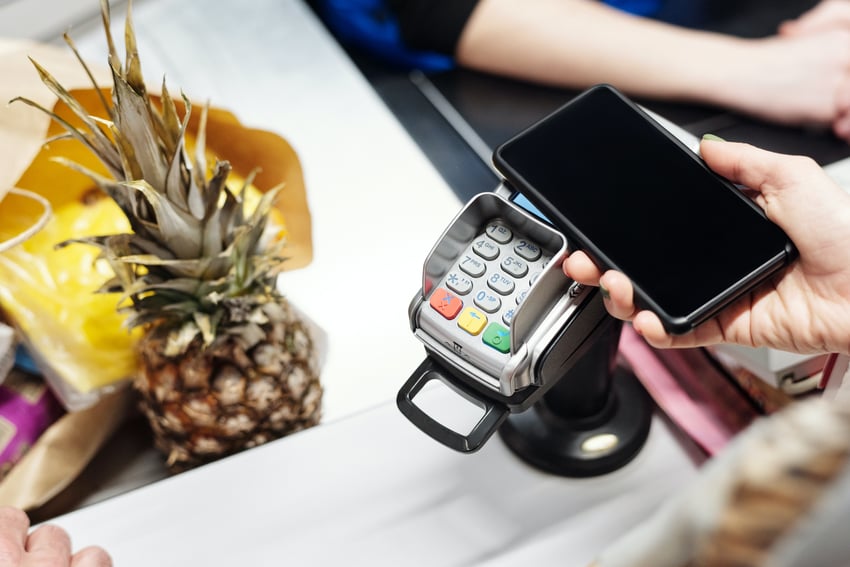 While self-scan and self-checkout have seen success, fully autonomous stores were viewed as problematic due to their binary nature and this hinders trial and adoption.
While self-scan and self-checkout have seen success, fully autonomous stores were viewed as problematic due to their binary nature and this hinders trial and adoption.
New grocery technologies worth the hype
Three grocery industry specialists delved into the pros and cons of various tech advancements, ranging from rapid e-commerce to the metaverse and in-store robotics to micro-fulfillment centers. Amid an overwhelming choice of tech solutions, these experts distinguished between technologies that deliver unequivocal value for both grocery consumers and retailers, and those that warrant a more wary approach.
Unilever has been active in the Metaverse, focusing on learning and building communities across their brands. They see commerce as a future stage. Although there isn't a clear use case for grocery in the Metaverse yet, it could potentially augment the physical in-store experience. Examples such as Carrefour using it as a recruitment tool and Domino's allowing pizza orders within the Metaverse were discussed.
Ahold Delhaize has seen success with ML Ops processes, enabling faster project launches. Unilever is employing dynamic content creation, factoring in variables like weather into their offers. The panel agreed that AI offers opportunities in marketing efficiency and effectiveness, audience targeting, shopper insights, personalized promotions, and adjusting merchandising to individual stores.
The panel stressed that software is as important as hardware when it comes to robotics and was considered easier to trial. They discussed using robotic pick arms for delicate grocery items like eggs, and highlighted the importance of integrating robotics with other technology and processes.
Quick commerce was recognized as important for providing timely product access. Partnerships with quick commerce providers could provide learning opportunities and in-house capability development. However, they stressed the need to find a balance between cost and delivery time, with predictability being key.
While self-scan and self-checkout have seen success, fully autonomous stores were viewed as problematic due to their binary nature and this hinders trial and adoption.
Key takeaways:
- To find ROI, consider the required processes and personnel, not just the technology.
- Experimentation is crucial, and metrics should be considered for adoption.
- Ideation is essential for clarifying the problem you aim to solve.
The future of brands
Track 3 of the day focused on optimizing between DTC (Direct-to-consumer) and wholesale strategies. Brands are rethinking their wholesale and DTC strategies to find an optimal balance between wholesale and DTC. They are also building a purpose-driven brand by incorporating purpose into their businesses and brand stories.
The panelists emphasized the importance of viewing DTC and wholesale not as competing strategies, but as complementary elements that serve different aspects of the customer journey. The objective is to utilize the strengths of both models to maximize reach and profitability. The speakers highlighted how understanding their customer journey is pivotal in tailoring both DTC and wholesale strategies. For instance, BARK utilizes social media engagement to better understand pet owners (their purchasers), which influences both their DTC and wholesale strategies.
Each panelist shared specific innovative tactics for resolving conflicts between DTC and wholesale strategies. Waldencast has shifted from pushing immediate purchases to offering free samples, a strategy that can be implemented in both DTC and wholesale contexts to enhance customer engagement. Tapestry underlined the importance of consistent messaging across all channels, ensuring that both DTC and wholesale initiatives are aligned and resonate with the same brand story.
Workshop sessions
The final track of the day focused on simplifying the e-commerce tech stack. Retailers and brands are implementing new technologies to improve their online offerings, resulting in a complex web of solutions and processes. Additionally, leaders discussed succeeding at social commerce, which is quickly evolving from content venues to commerce venues. Lastly, they discussed leveraging zero-party data, which is the data people voluntarily share with retailers and brands.
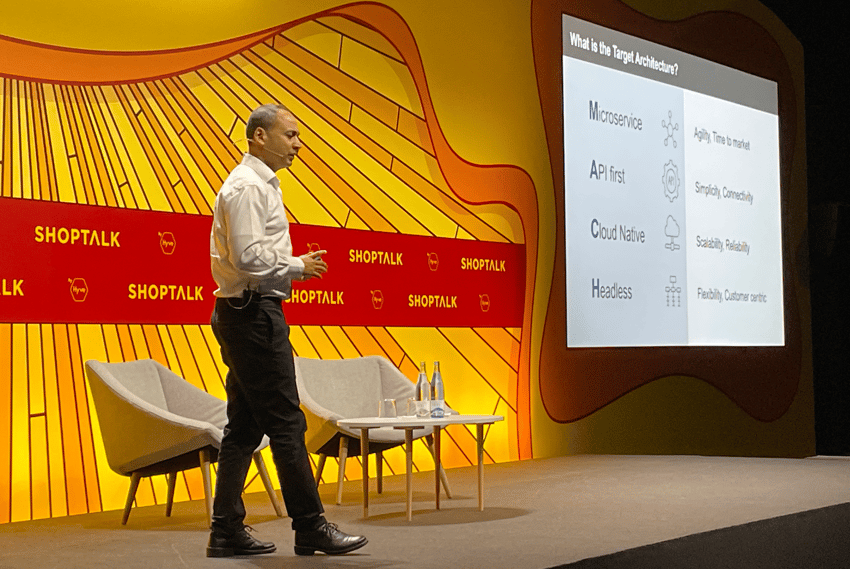 Bharat Bansal, Partner at Bain and Company, led an intriguing discussion on the complexities of modernizing the Ecommerce tech stack. Stating that it is an orchestration of multiple capabilities, not just one solution.
Bharat Bansal, Partner at Bain and Company, led an intriguing discussion on the complexities of modernizing the Ecommerce tech stack. Stating that it is an orchestration of multiple capabilities, not just one solution.
Simplifying the Ecommerce tech stack
Bharat Bansal, Partner, Bain and Company, led a discussion on the complexities of modernizing the ecommerce tech stack. The focus of the discussion was to understand why businesses need to simplify and modernize their Ecommerce operations to drive innovation, increase efficiency, and scale effectively.
Bansal pointed out that dissatisfaction with technology solutions often arises from; the need to introduce new features faster, rising costs, and struggles with scaling. These problems are not due to one solution or application but rather stem from the overall architecture of the tech stack. He also defined the Ecommerce tech stack as not just the customer-facing platforms but also the array of capabilities and solutions that come together to shape the customer's shopping experience. Suggesting that the journey towards modernizing the ecommerce tech stack should be guided by principles such as microservice architecture, API-first development, cloud-native applications, and headless commerce.
Bansal further identified five key decisions that businesses need to make in their modernization journey: whether to upgrade or replace existing solutions, whether to opt for best of breed solutions or a pre-packaged offering, whether to build internally or purchase/rent solutions, whether to pursue a brownfield (improving existing solutions) or greenfield (starting afresh) transformation, and whether to work in a product-based model or manage the transition as a large project.
Key takeaways:
- Simplification: Simplification is the key to driving innovation, change, and efficiency in technology operations.
- Orchestration of multiple capabilities: The Ecommerce tech stack is an orchestration of multiple capabilities, not just one solution.
- MACH: The guiding principles for designing a target state in the modernization journey should include microservice architecture, API-first development, cloud-native applications, and headless commerce.
- Key decision points: There are crucial decisions to make in the modernization journey, which include upgrading or replacing solutions, choosing between best-of-breed or pre-packaged solutions, deciding to build internally or rent/buy, and choosing between brownfield or greenfield transformation.
- You are unique: The specific modernization path for a business will depend on its unique needs and situation.
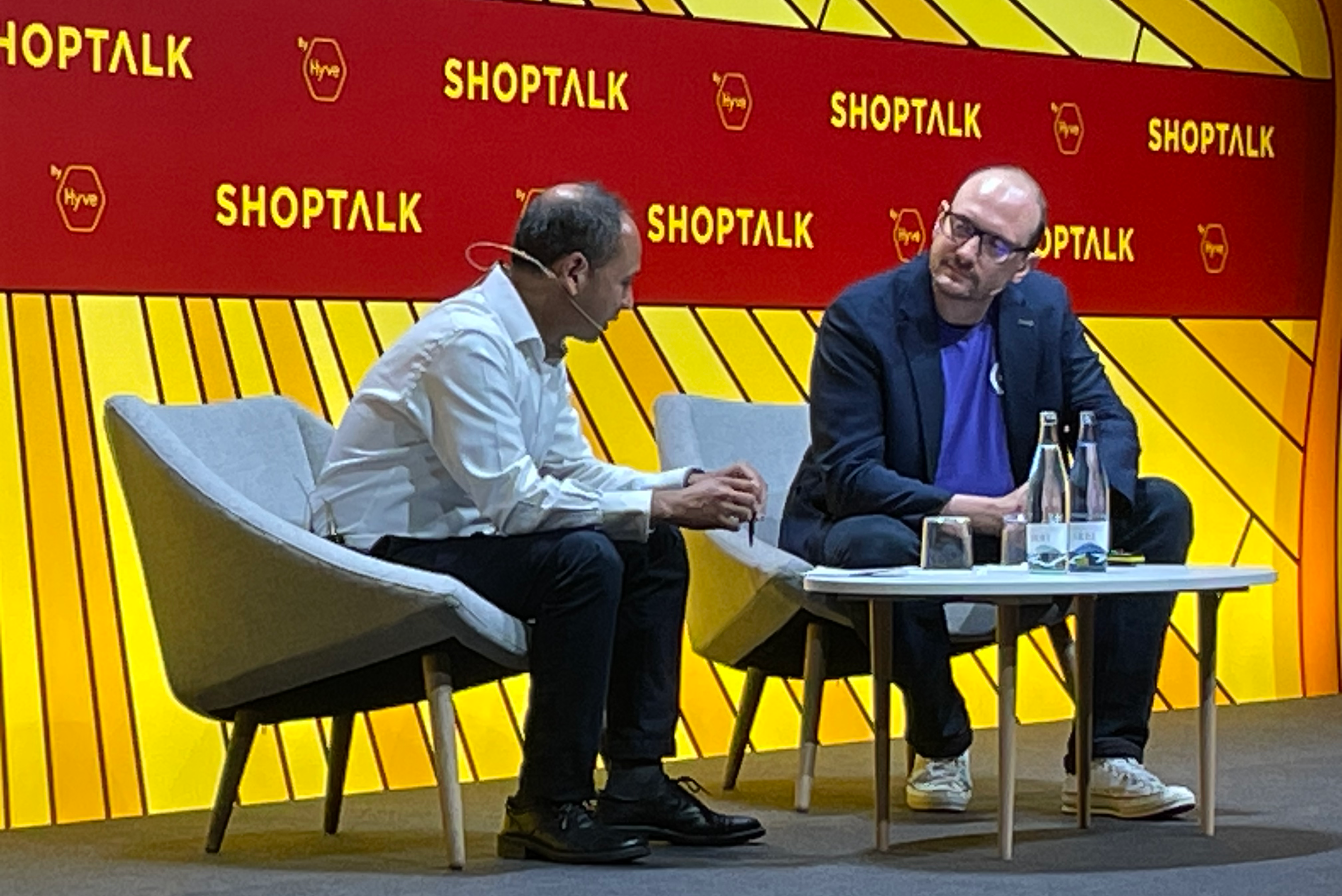 Bharat Bansal interviewing Andreas Westendörpf, Chief Technology Officer at Emma - The Sleep Company.
Bharat Bansal interviewing Andreas Westendörpf, Chief Technology Officer at Emma - The Sleep Company.
In the second part of the session Bansal interviewed Andreas Westendörpf, Chief Technology Officer, Emma - The Sleep Company, a young sleep company with a presence in 30 markets and revenues of 90 million, found their growth hindered by a monolithic tech system that couldn't keep up with their pace of business expansion. Recognizing the problem was not solely technical but also organizational, they decided to reinvent both their technological and organizational architectures.
They created the "Emma Commerce Operating System" (Emma Cos) for scalability and flexibility, and adopted a hands-on product evaluation approach. Their rollout plan began with smaller markets, helping identify and rectify issues before moving on to larger markets. The leadership promoted a culture of adaptability, flexibility, and empowerment, playing a crucial role in this transformative journey.
Key takeaways:
- You need the ability to change: Rapid business expansion can outpace the capabilities of a monolithic tech system, impacting a company's growth and agility.
- It not just about tech: A transformational approach is needed that addresses both the technical and organizational challenges. Leadership is crucial in shaping the vision, fostering a flexible and adaptable culture, and driving the transformational process. Boldness, ambition, and a readiness to iterate rapidly are vital to cope with the fast-paced changes in technology.
- Composable commerce: A composable and scalable system like "Emma Cos" can provide the needed flexibility and scalability for growth.
- Proof of concepts: A hands-on approach to product evaluation can be more effective than just trusting marketing materials.
- A phased rollout strategy: Starting with smaller markets, can help identify and fix issues early.
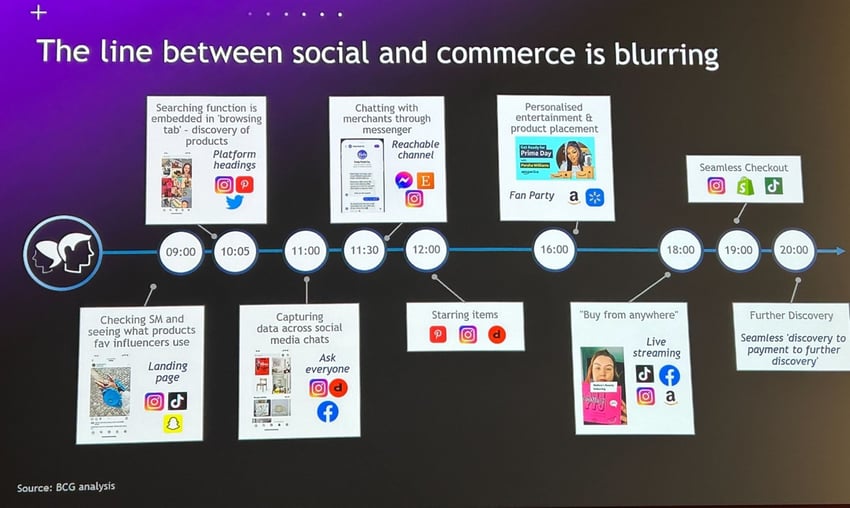 The fourth and final track focused a lot on technology solutions that enhance the physical retail experience, improve marketing and personalization, and optimize the supply chain.
The fourth and final track focused a lot on technology solutions that enhance the physical retail experience, improve marketing and personalization, and optimize the supply chain.
Social commerce
Social commerce, the fusion of social media and Ecommerce, is growing in relevance due to consumers' increasing engagement with transactions through social media platforms. While some larger retailers question the ROI of social commerce, brands such as Walmart and Mellow Beauty have embraced it, showing its effectiveness. China leads in social commerce due to high mobile and social media use. However, cultural behavior towards social commerce varies, making regional understanding essential.
Strategies for social commerce success include influencer marketing, peer-to-peer commerce, occasion-based marketing, and community engagement. The role of trust and safety in online marketplaces is also crucial. The effectiveness of these strategies was illustrated with examples from companies like Shein, Revolve, Nike, Petco, and HEWI, a luxury resell business.
HEWI has successfully integrated live streaming into their social commerce strategy, leading to increased customer engagement and sales. WhatsApp has evolved into a significant sales channel for HEWI, driving about 40% of their sales. The company plans to allow sellers to host their own live sessions to create a closer connection with customers.
Key takeaways:
- On the rise: Social commerce, integrating social media and Ecommerce, is becoming increasingly relevant, with major social media players investing heavily in this area.
- Cultural understanding: Essential for social commerce success due to regional differences in consumer behavior.
- Successful social commerce strategies include influencer marketing, peer-to-peer commerce, occasion-based marketing, and community engagement.
- Live streaming, as part of a social commerce strategy, can significantly increase customer engagement and sales.
- The live shopping model, which allows real-time browsing and purchase, can streamline the online selling process for luxury items and improve customer engagement. The ability for sellers to host their own live sessions can foster a more intimate connection with customers.
- Easy to use: Platforms for live shopping should be easy to integrate, user-friendly, and allow customers to shop without needing to download an app or leave the website
Leveraging zero-and first-party data
The shift away from third-party cookies is challenging many companies to rethink their approach to data collection and usage. This is leading to a stronger focus on zero- and first-party data, which is data directly collected from the customer, with their knowledge and consent.
This shift promotes more transparency and gives customers more control over their data, thereby fostering trust between the customer and the company. This trust can, in turn, lead to stronger customer relationships and potentially enhance customer loyalty. In this discussion, both Marc Hernandez from Mango and Camila Tomas Verdaguer from Puig emphasized the importance of putting the customer first and respecting their privacy. This includes being compliant with data regulations and considering the ethical implications of data usage.
However, they also noted the challenges associated with this shift, such as breaking down silos within organizations, managing the rapid changes in technology, and navigating the different data regulations in different countries. Despite these challenges, the overall sentiment was that the move towards a more privacy-focused, customer-centric approach to data is a positive one.
Overall, it's clear that the demise of third-party cookies is driving significant changes in the digital marketing and data landscapes, but it's also opening up opportunities for companies to build stronger, more trusting relationships with their customers.
In summary
Day three of Shoptalk Europe 2023 was packed with informative sessions and discussions that provided valuable insights into the latest trends and technologies in the retail and e-commerce industry. From transforming the store workforce to building a resilient supply chain, leaders discussed how to stay ahead of the game and succeed in the ever-evolving retail landscape.
Attendees left the conference with a better understanding of how to create outstanding retail experiences, optimize between DTC and wholesale strategies, and leverage zero-party data to succeed in the digital economy.
